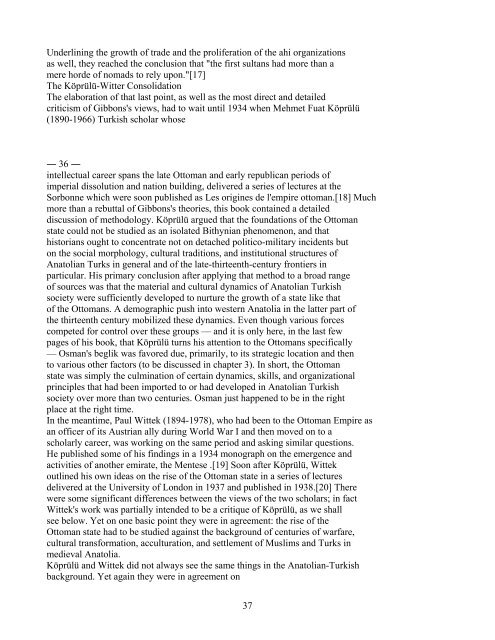Between Two Worlds Kafadar.pdf
Between Two Worlds Kafadar.pdf
Between Two Worlds Kafadar.pdf
Create successful ePaper yourself
Turn your PDF publications into a flip-book with our unique Google optimized e-Paper software.
Underlining the growth of trade and the proliferation of the ahi organizations<br />
as well, they reached the conclusion that "the first sultans had more than a<br />
mere horde of nomads to rely upon."[17]<br />
The Köprülü-Witter Consolidation<br />
The elaboration of that last point, as well as the most direct and detailed<br />
criticism of Gibbons's views, had to wait until 1934 when Mehmet Fuat Köprülü<br />
(1890-1966) Turkish scholar whose<br />
― 36 ―<br />
intellectual career spans the late Ottoman and early republican periods of<br />
imperial dissolution and nation building, delivered a series of lectures at the<br />
Sorbonne which were soon published as Les origines de l'empire ottoman.[18] Much<br />
more than a rebuttal of Gibbons's theories, this book contained a detailed<br />
discussion of methodology. Köprülü argued that the foundations of the Ottoman<br />
state could not be studied as an isolated Bithynian phenomenon, and that<br />
historians ought to concentrate not on detached politico-military incidents but<br />
on the social morphology, cultural traditions, and institutional structures of<br />
Anatolian Turks in general and of the late-thirteenth-century frontiers in<br />
particular. His primary conclusion after applying that method to a broad range<br />
of sources was that the material and cultural dynamics of Anatolian Turkish<br />
society were sufficiently developed to nurture the growth of a state like that<br />
of the Ottomans. A demographic push into western Anatolia in the latter part of<br />
the thirteenth century mobilized these dynamics. Even though various forces<br />
competed for control over these groups — and it is only here, in the last few<br />
pages of his book, that Köprülü turns his attention to the Ottomans specifically<br />
— Osman's beglik was favored due, primarily, to its strategic location and then<br />
to various other factors (to be discussed in chapter 3). In short, the Ottoman<br />
state was simply the culmination of certain dynamics, skills, and organizational<br />
principles that had been imported to or had developed in Anatolian Turkish<br />
society over more than two centuries. Osman just happened to be in the right<br />
place at the right time.<br />
In the meantime, Paul Wittek (1894-1978), who had been to the Ottoman Empire as<br />
an officer of its Austrian ally during World War I and then moved on to a<br />
scholarly career, was working on the same period and asking similar questions.<br />
He published some of his findings in a 1934 monograph on the emergence and<br />
activities of another emirate, the Mentese .[19] Soon after Köprülü, Wittek<br />
outlined his own ideas on the rise of the Ottoman state in a series of lectures<br />
delivered at the University of London in 1937 and published in 1938.[20] There<br />
were some significant differences between the views of the two scholars; in fact<br />
Wittek's work was partially intended to be a critique of Köprülü, as we shall<br />
see below. Yet on one basic point they were in agreement: the rise of the<br />
Ottoman state had to be studied against the background of centuries of warfare,<br />
cultural transformation, acculturation, and settlement of Muslims and Turks in<br />
medieval Anatolia.<br />
Köprülü and Wittek did not always see the same things in the Anatolian-Turkish<br />
background. Yet again they were in agreement on<br />
37













